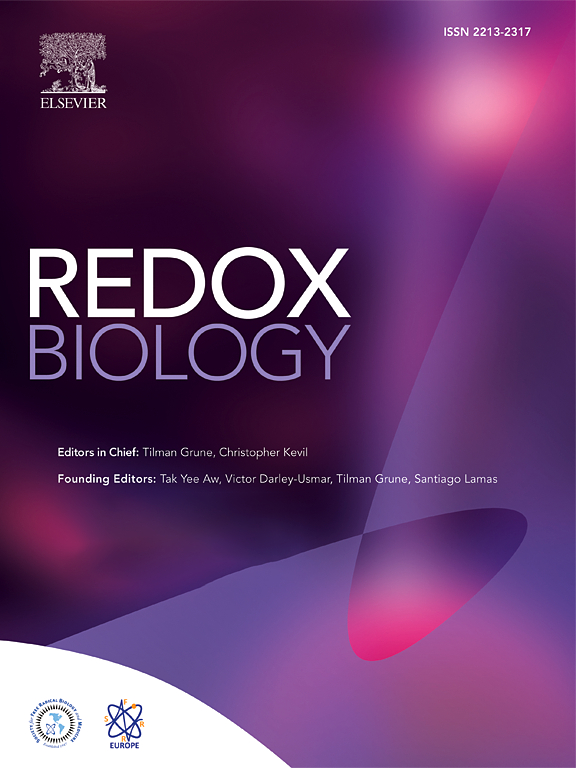Translocation of SIRT6 promotes glycolysis reprogramming to exacerbate diabetic angiopathy
IF 10.7
1区 生物学
Q1 BIOCHEMISTRY & MOLECULAR BIOLOGY
引用次数: 0
Abstract
Diabetic angiopathy, a major complication of type 2 diabetes mellitus (T2DM), is driven by vascular dysfunction, metabolic reprogramming, and oxidative stress. NAD+-dependent deacetylase SIRT6, located in the nucleus, is recognized for its role in modulating cardiovascular and metabolic homeostasis through histone deacetylation. However, the functions and mechanisms of accumulation of cytoplasmic SIRT6 in T2DM remain to be elucidated. Herein, a previously unrecognized cytoplasmic role for SIRT6 is identified in promoting pathological glycolysis during diabetic vascular remodeling. Vascular smooth muscle cell (VSMC) proliferation is observed, which is correlated with protein deacetylation, especially SIRT6, which translocated to the cytoplasm mediated by Importin 13 (IPO13). Furthermore, the accumulation of cytoplasmic SIRT6 facilitates its interaction with enolase 3 (ENO3), a newly discovered downstream target. This interaction promotes ENO3 deacetylation, enhances downstream phosphoenolpyruvic acid (PEP) levels, and thereby drives glycolysis reprogramming, ultimately leading to the pathological changes associated with diabetic angiopathy. Notably, exogenous hydrogen sulfide (H2S) restores S-sulfhydration of SIRT6 at cysteine 141, counteracting the SIRT6-ENO3 interaction, suppressing glycolysis, and mitigating VSMC hyperproliferation. This study provides novel insights into the SIRT6-ENO3 pathway through regulating vascular glycolysis reprogramming, highlighting the therapeutic potential of targeting SIRT6 in the management of diabetic angiopathy.

SIRT6易位促进糖酵解重编程,加重糖尿病血管病变
糖尿病血管病变是2型糖尿病(T2DM)的主要并发症,由血管功能障碍、代谢重编程和氧化应激驱动。NAD+依赖的去乙酰化酶SIRT6位于细胞核中,被认为通过组蛋白去乙酰化调节心血管和代谢稳态。然而,胞质SIRT6在T2DM中积累的功能和机制仍有待阐明。本研究发现,在糖尿病血管重构过程中,SIRT6在促进病理性糖酵解中的细胞质作用是以前未被认识到的。血管平滑肌细胞(Vascular smooth muscle cell, VSMC)的增殖与蛋白去乙酰化有关,尤其是SIRT6,其转运到由Importin 13 (IPO13)介导的细胞质中。此外,胞质SIRT6的积累促进了其与烯醇化酶3 (ENO3)的相互作用,这是一个新发现的下游靶标。这种相互作用促进ENO3去乙酰化,增强下游磷酸烯醇丙酮酸(PEP)水平,从而驱动糖酵解重编程,最终导致与糖尿病血管病变相关的病理改变。值得注意的是,外源硫化氢(H2S)恢复SIRT6在半胱氨酸141处的s -巯基化,抵消SIRT6- eno3相互作用,抑制糖酵解,减轻VSMC过度增殖。本研究通过调节血管糖酵解重编程对SIRT6- eno3通路提供了新的见解,突出了靶向SIRT6在糖尿病血管病变治疗中的治疗潜力。
本文章由计算机程序翻译,如有差异,请以英文原文为准。
求助全文
约1分钟内获得全文
求助全文
来源期刊

Redox Biology
BIOCHEMISTRY & MOLECULAR BIOLOGY-
CiteScore
19.90
自引率
3.50%
发文量
318
审稿时长
25 days
期刊介绍:
Redox Biology is the official journal of the Society for Redox Biology and Medicine and the Society for Free Radical Research-Europe. It is also affiliated with the International Society for Free Radical Research (SFRRI). This journal serves as a platform for publishing pioneering research, innovative methods, and comprehensive review articles in the field of redox biology, encompassing both health and disease.
Redox Biology welcomes various forms of contributions, including research articles (short or full communications), methods, mini-reviews, and commentaries. Through its diverse range of published content, Redox Biology aims to foster advancements and insights in the understanding of redox biology and its implications.
 求助内容:
求助内容: 应助结果提醒方式:
应助结果提醒方式:


